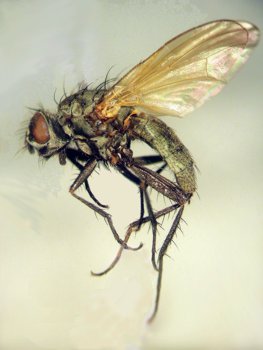Pests
Delia floralis (Fallen) - Turnip Root Fly, Summer Cabbage Fly.
Systematic position.
Class Insecta, order Diptera, family Anthomyiidae, genus Delia.Synonyms.
Hylemya floralis (Fallen) (= Chortophila, Phorbia).Biological group.
Oligophagous pest of cruciferous cultures.Morphology and biology.
Closely related to Delia radicum (L.) in morphology and biology, differing in larger size (7-8 mm); body yellow-gray, wings transparent, yellowish, with yellow veins. Males differ in having complete row of long anteroventral setae on hind femur. Eggs are laid 7-10 days after imago emergence; oviposition beginning one month later than the Spring Cabbage Fly. Frequently mass egg laying coincides in D. floralis and in D. radicum of the 2nd generation. Eggs white, elongated, cigar-shaped, differ in shorter longitudinal groove. They are laid in botryoidal, weakly united groups, in groups of 30-40 eggs, on plant at root collar or on ground at a stalk. Often several females lay eggs on one plant. Larva apodal, thick, white or yellow, shining, hatching in 5-14 days. It has 2 spiracular plates on hind apex of abdomen. 6 tubercles of equal shape and size are located around the plates. Larvae eat young roots or live inside the main root of a plant. The pest damages crucifers until the end of vegetation season because of expanded flight period. Larvae feed over 35-40 days, molting three times. Pupation occurs in ground at depth 10-30 cm. Puparium 6-6.5 mm in length, brown.Distribution.
Western Europe (from northern Scandinavia to Middle Europe), Northeast China, Korea peninsula, Japan, and North America (including Alaska and Labrador). In the former USSR it is distributed mainly in Non-Chernozem zone of the European part, in Siberia and the Far East, including forest-tundra and taiga regions of the Far North (Yakutia and Kamchatka).Ecology.
Everywhere monovoltine. It is considerably connected to peaty soils. Imago emergence of D. floralis begins later than this in D. radicum, i.e., at soil temperature 18 degrees celcius at depth of puparia location. In the south the flight usually occurs at the end of May, in the Moscow Region in June, and in the north at the end of June or in the beginning of July. Intensity of the flight activity rises after precipitations, which accelerate development of pupae. Constant reservations are biotopes with wild and weed crucifers, from where the fly passes to vegetable cultures. Develops on Barbarea ortoceras, Lepidium sibiricum, Roripa amphibian, Barbaraea sp., Erysimum cheiranthoides etc. The pest has high plasticity, i.e., its pupae endure frosts to -33°C; however, humidity levels of 50% and lower is pernicious. Eggs perish at temperatures of 35°C and higher. Sufficient water levels in host plant has high significance for normal development of larvae. The threshold of development of the insect is 6°C.Economic significance.
Larvae damage roots of various cultivars of cabbage, of garden radish, turnip, radish, swede and other cruciferous cultures. Damaged plants retard in growth, develop poorly, and produce lowered yield. Measures of control include early terms of pricking out strong healthy sprouts inserted in peat-compost pots, additional fertilizing, deep autumn plowing of fields after harvest of cruciferous root crops and insecticide treatments during mass flight of the fly.Related references.
Dzholova, N.G. 1965. Insect pests of vegetable crops in Baikal region. Moscow: Nauka, 80 p. (in Russian).El.berg, K.Yu. 1981. Antomyiidae. In: Narchuk, E.P. & Tryapitsyn, V.A., eds. Insects and mites - pests of agricultural plants. V. 4. Hymenoptera and Diptera. Leningrad: Nauka, p. 188-198 (in Russian).
Rogochaya, E.G. 1974. Antomyiidae. In: Vasil.ev, V.P., ed. Pests of agricultural crops and forest plantations. V.2. Kiev: Urozhai, p. 540-548 (in Russian).
Semakov, V.V. 1972. On ecology of the summer cabbage fly in the Kamchatka Region. Ekologiya 5: p. 87-90 (in Russian).
Stepanova, L.A. 1962. Experience of the ecological analysis of conditions of development of pests of cruciferous vegetable cultures in nature. Entomologicheskoe obozrenie 41(4): p. 721-736 (in Russian).


